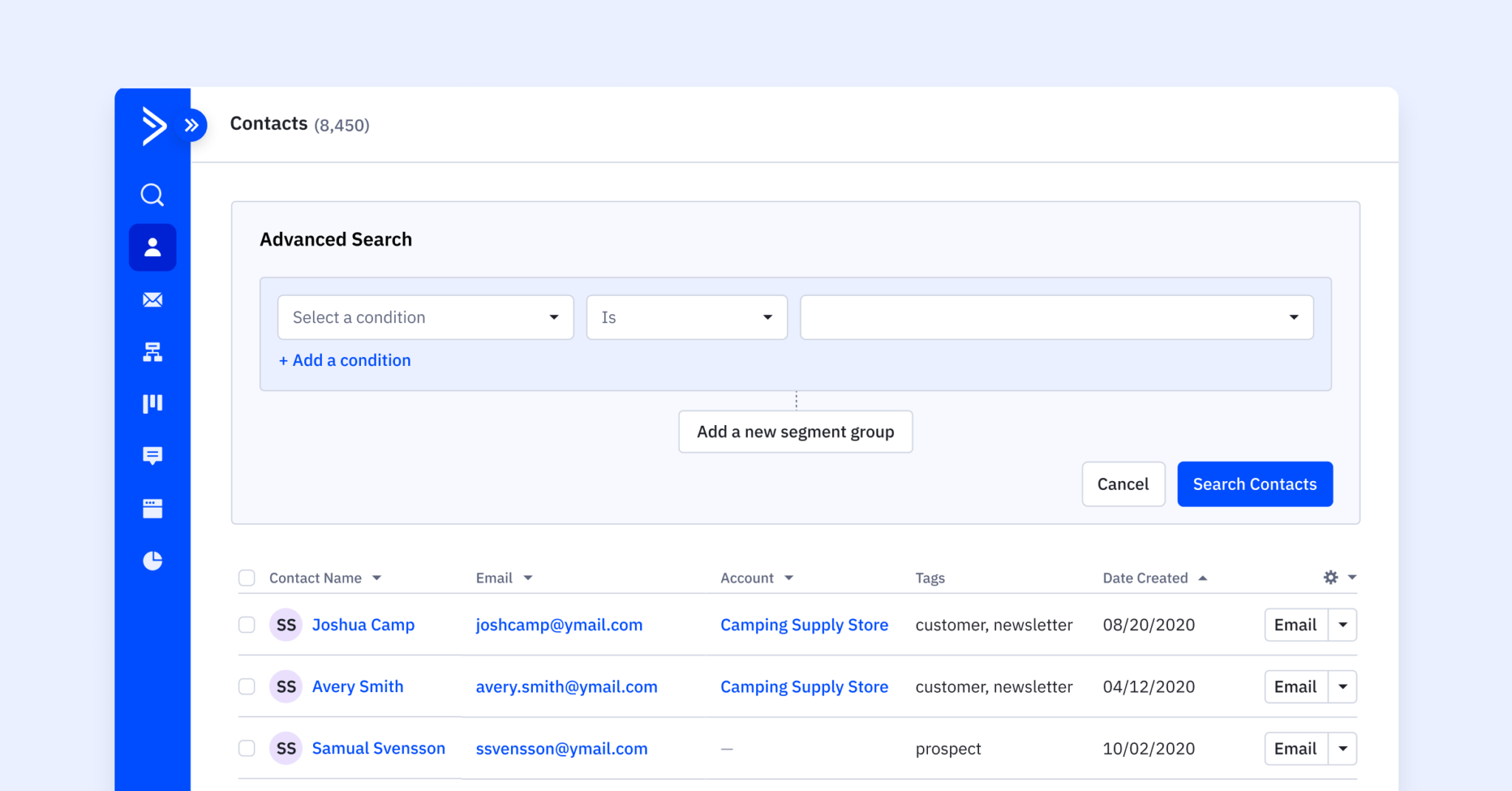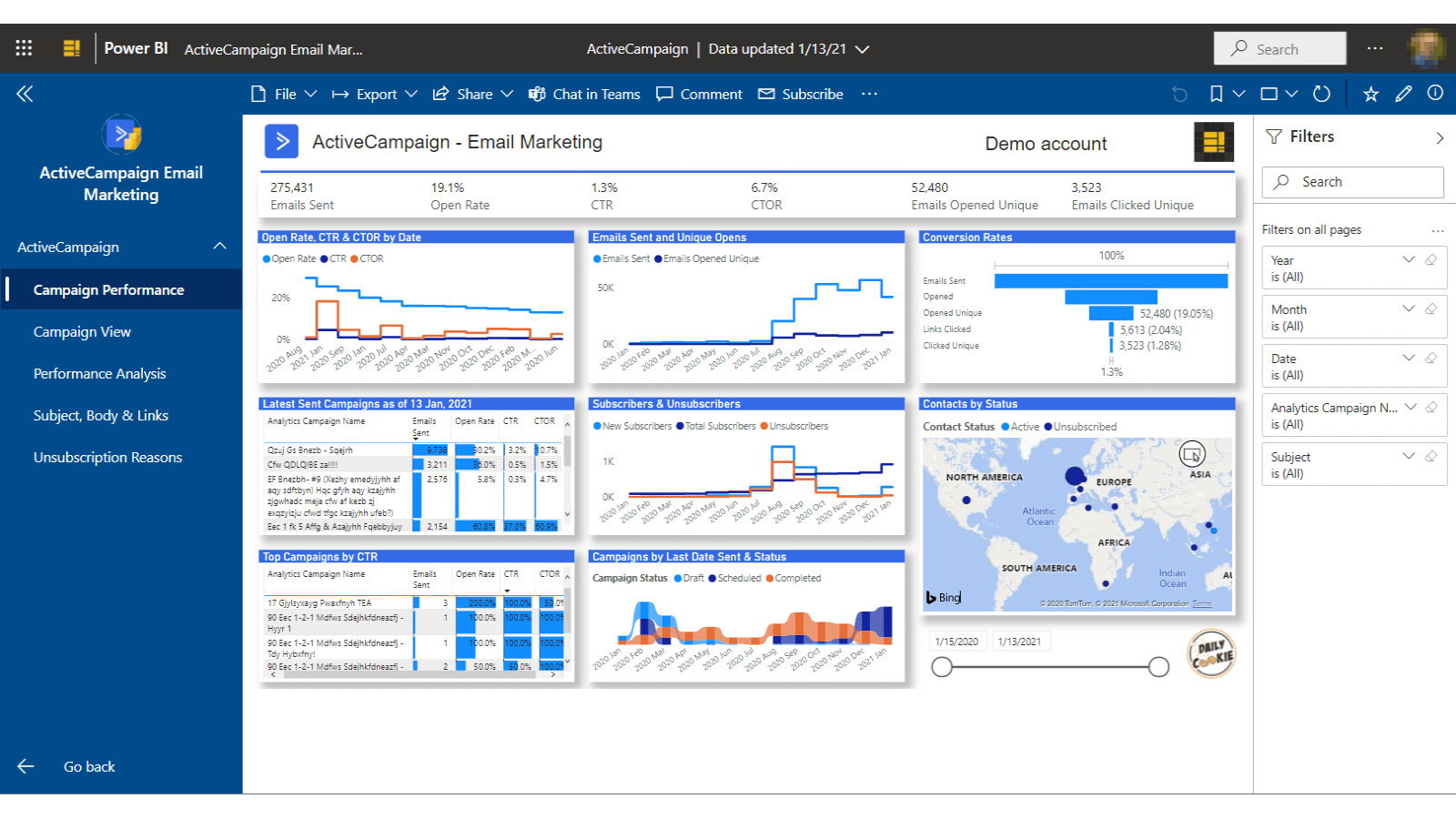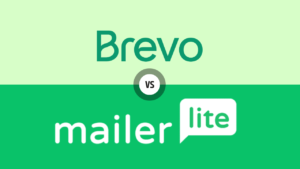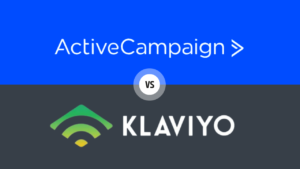Introduction to Getresponse vs Activecampaign
Choosing the correct email marketing platform can be a game-changer for businesses trying to effectively engage their audience in today’s fast-shifting digital marketplace. Getresponse and ActiveCampaign stand out as two of the top possibilities among the multitude of options accessible. This blog post compares Getresponse vs ActiveCampaign in great detail, looking at important features including email design, automation capabilities, customer service, pricing, and much more. Our mission is to provide you with the knowledge necessary to choose the platform that will most effectively support your marketing plans and business objectives.
Table of Contents
Ease of Use and Interface
ActiveCampaign is popular for having powerful automation abilities and a wide range of features. But with this comes the learning curve. ActiveCampaign is not very user-friendly, especially for a beginner, and it will take some time to get used to it. The dashboard and the campaign setup are pretty detailed, offering a good amount of customization, which may come off as overwhelming for beginning users. The features available in ActiveCampaign are better suited to advanced users, offering deep data analytics, detailed tools for the management of campaigns, and complex automation workflows. ActiveCampaign is a good choice for those users who seek advanced marketing automation tools and are ready to spend time learning the details of the software.
On the other hand, GetResponse targets simplicity and user-friendliness, so this is often considered the best tool for email marketing by small businesses and individuals just starting in email marketing. It has a fresh, neat dashboard from where all the features are easily navigable. From creating email campaigns to landing pages and automation sequences, GetResponse ensures every step is easy to navigate through. GetResponse still offers a complete set of marketing tools but displayed in a very friendly manner.


When comparing Getresponse vs ActiveCampaign, both look modern and visually clean, but GetResponse has a layout that is more navigable for those who want simplicity. ActiveCampaign’s interface is very functional but needs a lot of time to become familiar with it because this email marketing platform offers many features and a lot of customization opportunities.
Email Design and Templates
GetResponse is famous for having very advanced and responsive templates, giving your brand an easy opportunity for alteration. Their interfaces on design are friendly to users and super comfortable with placements of pictures, buttons, and even links to social media. It will also help with some features, for example, it will provide a way to design and edit email templates for a device-specific email so the email looks good on all screens.
On the other hand, ActiveCampaign shines with its next-level automation features, which by now—years into its life, in most cases—have made the maneuvering quite seamless with the emails already in place. ActiveCampaign allows the possibility of very great branding of the emails, as it goes as far as picking the details from your contact list and presenting focused content that will be true to the ears of the people you are trying to reach. Besides, ActiveCampaign templates have high conversion rates.


When comparing email design and templates between Getresponse vs ActiveCampaign, each provider offers a compelling solution that is specifically designed to meet the demands of modern marketing. Your decision can depend on how much automation and personalization you need for your campaigns. Rich media, dynamic content, and compelling calls to action can significantly boost your email marketing success.
Automation Capabilities
Getresponse has a friendly automation that can be used even by beginners in email marketing. The suite of automation comes with intuitive workflows, and the user is further guided by the availability of pre-designed templates to help in triggering, conditions, and action definitions. This simplicity is very powerful, as GetResponse delivers its high-level segmentation and customization features to make sure that the right messages come to the right people at the right time.
ActiveCampaign takes automation a step further, offering a more detailed level of control and customization. They also improved the visual automation builder, giving marketers the power to create complex workflows that could speak to users in various complex scenarios based on behavior, engagement, and user data points. This would eventually be a very useful platform for any organization because of the deeper levels of integration between their email marketing and customer relationship management (CRM), which provides a unified experience through all touchpoints.


Comparing Getresponse vs ActiveCampaign for their capabilities in automation shows that for those concerned more with simplicity and ease of use, Getresponse would be a nice place to start. However, in case those needs develop into something more complex like data-driven automation strategies then ActiveCampaign’s advanced functionality offers the tools to be able to manage any kind of complex campaign. Both platforms excel in their ways.
List Management and Segmentation
GetResponse makes it easy for the user to add, remove, and organize contacts through very friendly and easily navigable list management tools. Its segmentation is powerful, for the user cut lists easily, based on a demographic, behavioral segmentation, and engagement level of contacts by a marketer. It makes it easy to tailor your messaging for relevance and effectiveness in your campaigns to different segments of your audience.
ActiveCampaign, on the other hand, excels in its advanced segmentation capabilities. It allows for more detailed segmentation criteria, including past purchase behavior, interaction with your site, and custom fields. This level of detail allows for extremely laser-focused campaigns that speak directly to the individual needs and interests of your contacts, potentially leading to higher conversion rates.


Comparing Getresponse vs ActiveCampaign in terms of list management and segmentation shows that Getresponse would be ideal for users who simply need to be able to manage lists when it comes to segmentation. On the other hand, ActiveCampaign is more suitable for those with businesses and more complicated needs of segmentation across a whole host of data points.
Deliverability and Security
Getresponse includes some advanced deliverability approaches like IP warming, DKIM (DomainKeys Identified Mail), and SPF (Sender Policy Framework) records that ensure a high inbox delivery success rate. This helps in authenticating your emails from landing in spam. These include strong security measures, such as GDPR compliance and data encryption to keep subscribers’ data safe.
ActiveCampaign also has higher delivery rates. Concerning security, they authenticate with very similar protocols to ensure uniform delivery. This emphasizes that the sender’s reputation is machine-learning and handled by the processes in an automated fashion. ActiveCampaign assures security through apparently visible compliance with international standards, two-factor authentications, and tools for continual monitoring against tracking down and preventing the perceived threat.


Comparing Getresponse vs. ActiveCampaign in deliverability and security, it’s clear that Getresponse pays more attention to full protection and secure authentication tools, while ActiveCampaign focuses on modern technologies to accelerate the speed of email delivery and, at the same time, keep the data fully protected. In the end, the features that deal with your security requirements and email marketing strategy will likely be the most important considerations for you.
Integrations and Add-ons
Getresponse offers one of the widest and fullest lists of integration with leading platforms like Shopify, Magento, or Salesforce. All of this is thanks to integrations that move customer data from one system to another which makes email campaigns even more personal and speedy. Besides, Getresponse has great add-ons, such as tools to build landing pages and webinars, all for its core email marketing service and to give users a more comprehensive marketing toolkit.
ActiveCampaign has among the best CRM and sales automation tools. This makes ActiveCampaign a neat choice for businesses whose main objective is customer relationship management and are searching for a way to make it one platform for their sales and marketing activities. ActiveCampaign deeply integrates your data to make sure every customer interaction can be easily tracked and leveraged for more tailored and effective email marketing.


Comparing Getresponse vs ActiveCampaign in automation, we see that Getresponse is quite beginner-user-friendly so it’s good for beginners, while ActiveCampaign is deep in customization and integration, making it more fitting for experienced users. And with any kind of platform that you choose to use, automation is a big part, and will definitely help to increase your marketing efforts massively making sure that your message gets out in time and gets to the right people.
Reporting and Analytics
Getresponse offers some great reporting features that track all the essentials like open rates, click-through rates, and unsubscribe rates. On top of that, it also offers more advanced analytics, like click heat maps, rates, the way your subscribers interact with your email marketing over time, and the performance of specific email content. This information is valuable for marketers looking to improve their strategies and engagement.
ActiveCampaign goes a step further by integrating its reporting with its CRM and automation features. This allows the user to see how a subscriber has interacted with their emails and how these interactions have corresponded with sales or stages in the customer lifecycle. With its split testing features, you can also evaluate and assess the effectiveness of various email methods directly, allowing you to make decisions based on data.


Comparing GetResponse vs ActiveCampaign in reporting and analytics, it’s clear that both will provide powerful options by which email marketers can measure the success of their campaign efforts. Both of these give a highly detailed look into the performance of campaigns, subscriber behaviors, and e-mail engagement metrics. However, companies that value in-depth analysis and highly targeted campaigns may find some advantage in ActiveCampaign’s CRM connectivity and comprehensive testing tools.
Customer Support Services
GetResponse offers a comprehensive help center where the user is offered all forms of assistance through guides, tutorials, and FAQs that help in the usage of features and troubleshooting issues when using the features. GetResponse offers live chat support and email assistance to its users at all times for any kind of assistance they may need. Their focus on delivering prompt and helpful responses shows their commitment to user satisfaction.
ActiveCampaign, on the other hand, has a multi-tiered support approach. They also provide one-on-one training sessions and account management support, in addition to a comprehensive knowledge base and email support. This customization approach will allow users to get assistance on issues and also how to use the platform for the scaling of their businesses.
Comparing Getresponse to ActiveCampaign, on the kind of customer support services they offer, out of the two, Getresponse is better because if a user needs help at any time, there is live chat support and email 24/7. ActiveCampaign brings a significantly more personable touch to their support, even offering one-on-one training and an account manager for businesses looking to elevate their marketing strategy.
Pricing and Plans
Getresponse’s price is structured to grow with your business. They offer a free plan for those just starting out but with limited features and caps on the number of subscribers. As your need grows, you can move up to more detailed plans with advanced features such as automation, segmentation, and webinars. Because of their flexible pricing, Getresponse would be an attractive choice for people looking forward to scaling their business
On the other hand, ActiveCampaign wants to give something classy even with the lowest plans while focusing more on quality engagement instead of filling in the user’s inbox with emails. The plans are based on the number of contacts in your list, and each tier offers automation and CRM features. This is the reason ActiveCampaign can suit a business dealing in engaging customers with meaningfulness while giving them the whole range of required analytics.


Comparing Getresponse vs ActiveCampaign, we see that GetResponse is very attractive for those looking to scale with flexible options designed to fit businesses at any size or growth stage. ActiveCampaign offers more of a fully rounded experience at any of its price points with an emphasis on strength in toolsets for a wide variety of customer engagement and analytic needs. Both platforms show pricing that makes it clear for the business to choose the right plan to undergo marketing strategy by budget limitations.
Pros and Cons of Getresponse
Pros:
- Comprehensive Feature Set: Beyond email marketing, Getresponse provides an extensive range of capabilities, including landing pages, webinars, automation, and a CRM system. Several marketing initiatives can be easily integrated into one platform thanks to this extensive package.
- User-Friendly Interface: The platform’s user-friendliness and straightforward design are well-known. Users of various skill levels may create emails and landing pages more easily thanks to the drag-and-drop editor.
- Advanced Automation: Getresponse’s automation features are strong, enabling customers to design detailed email sequences based on behavior. This capability is especially useful for the mass personalization of communications and lead nurturing.
- High Deliverability Rates: Successful campaigns must guarantee that emails arrive in the inbox of the intended recipient. Getresponse has a reputation for having excellent deliverability rates, which boosts the efficiency of email marketing campaigns.
Cons:
- Pricing Structure: The cost increases with the size of your subscriber list. It can get pricey for companies that have a lot of contacts.
- Complexity for Beginners: While the interface is easy to use, beginners may find the extensive feature set to be intimidating. It could take some time for new users to take full advantage of the platform’s features.
- Limited Free Plan: Unlike their competitors, Getresponse’s free plan is quite limited. This could be a disadvantage for startups or small enterprises who want to test the platform out before making a big financial commitment.
- Customization Limitations: Certain themes have limitations when it comes to personalization, according to certain users. For brands with certain design specifications, this can be difficult.
Pros and Cons of ActiveCampaign
Pros:
- Superior Automation: Because of its sophisticated automation features, which give customers precise control over processes and segmentation, ActiveCampaign is famous. This allows for incredibly precise customization of communications.
- Comprehensive CRM Integration: A CRM system is integrated into ActiveCampaign, unlike many other email marketing platforms, and it works perfectly with its automation features. This is especially helpful for aligning marketing and sales.
- Extensive Third-Party Integrations: The platform provides many possibilities for interfaces with other programs and services, which improves its value and allows businesses to build a more interconnected tech stack.
- Exceptional Customer Support: High-quality customer service from ActiveCampaign, which includes live chat, email support, and a comprehensive knowledge base, is highly valued. This guarantees that consumers may obtain assistance as needed.
Cons:
- Steep Learning Curve: ActiveCampaign’s advanced features and functionalities can be intimidating for beginners. It will take a lot of time to fully utilize the possibilities of the platform.
- Pricing: Like Getresponse, the price of ActiveCampaign can rise quickly as the number of contacts does. This can make it costly for smaller businesses with limited resources.
- Complexity Can Overwhelm: Although it is an advantage, the depth of features can also be a disadvantage. It is possible for those searching for straightforward solutions to find the platform overly complicated.
- Limited Template Designs: A few users have pointed out that there is a need for improvement in terms of the email and landing page template designs’ scope and level of modification flexibility.
User Reviews and Testimonials
Most Getresponse reviews indicate that the interface is friendly and full of features. Most users love it because it is able to take care of quite a lot when it comes to digital marketing, ranging from automation to landing pages and webinars, all under one package. It is widely known that Getresponse offers excellent customer assistance and that even a non-technical user can create complex, automation-rich workflows.
ActiveCampaign reviews tend to focus on the platform’s advanced automation and segmentation capabilities. What is great for customers is the great level of flexibility in making customizations of the email campaign in all different ways. CRM functionality is valued due to the features supporting smooth transitioning from marketing processes to sales processes in an improved manner towards better operational efficiency of the business.In addition, the learning resources provided, such as webinars and tutorials, were rated as effective in ensuring that users derive maximum benefit from the service.
Comparing Getresponse and ActiveCampaign from reviews by the users and testimonials, it is very clear that both have systems with a place for the broad scope of marketing needs. Maybe that’s one of the reasons GetResponse often ends up well-rated, connected with its all-in-one capabilities and easy tools that perfectly fit small to medium sized businesses and marketers who need simplicity. ActiveCampaign, on the other hand, is praised for superior automation features and CRM integration. This is the first preference for any business looking to scale with marketing precision and personalization.
Final Verdict (TLDR)
GetResponse is one of my recommendations to any business for the best marketing solutions. It offers easy solutions that are comfortable for use, a rich feature set at a modest price, mainly targeting small and medium businesses. With an intuitive platform design and transparent pricing, your marketing campaigns are live in no time.
ActiveCampaign, on the other hand, stands out for its advanced automation and CRM integration capabilities.Perfect for every business, both small and big, which requires advanced marketing automation flows and deep customer segmentation. The one and only ActiveCampaign toolkit for teams and businesses that take customer experience—from personalized to a seriously different level—and connect their marketing activity not only to sales but also to CRM processes.
Comparing Getresponse vs ActiveCampaign shows that they both come with many features in email marketing and automation. Getresponse provides a very intuitive platform and comprehensive marketing tools, making it suitable for marketers of all levels. CRM that integrates into businesses that want to go next level with their personalized marketing, and sales alignment.



